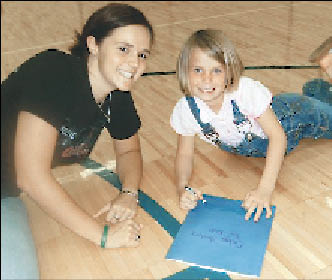Indianapolis, Ind.
(317) 921-1798
http://www.collegementors.org
Objective: Get disadvantaged youth excited about higher education and increase their opportunities to succeed.
 |
|
College Bound: Danae Beeler, a student at Grace College in Winona Lake, Ind., gives her “little buddy” Whitney a glimpse of college life. Photo: College Mentors for Kids |
In a Nutshell: First- through fourth-graders are paired with college student mentors, going to a college campus each week for activities that focus on higher education and career, culture and diversity, and community service. The youths and mentors commit to one year of participation, but are encouraged to participate for four years.
Two-hour-long group activities begin with a snack and reading aloud the “book of the week” as a way to introduce the day’s topic. After a hands-on activity – College Mentors has a database of 400 – mentors and children discuss the “college question of the week,” such as, “What classes can college students take to learn about working for a newspaper?”
Transportation is provided at no cost by College Mentors, usually through an arrangement with a university’s bus system.
When and Where It Happens: There are chapters at 20 colleges and universities in Indiana and one in Illinois. Youth visit campus once a week on a weekday afternoon.
Who Started It and Who Runs It: In 1995, Indiana University undergraduates Heidi Schmidt and Kristen Huang created the program, after an assessment of youth programming in their area. They found a gap in services for younger elementary school youths and aimed the program at addressing that gap.
CEO Erin Slater oversees a staff of six. About 900 college students volunteered as mentors for the program in the 2007-08 school year.
Overcoming Obstacles: Handling rapid growth was a challenge on two fronts: thin representation outside the office, and cramped quarters inside. The organization needed more workers in the field to help its paid staff handle the increasing number of youth participants. At the headquarters in Indianapolis, College Mentor’s group of 20 regular volunteers were indispensable in making the program work, but cramped in an office space designed for a maximum of 10 people.
The field workload was alleviated by establishing an internship program that gives college students leadership roles in various chapters and programs. The headquarters moved to a larger location.
Cost: Last year’s operating budget was just over $1 million. It costs approximately $1,000 to support one mentor-child pair in the program for a year.
Who Pays: Supporters include the Lumina Foundation for Education, the Indianapolis Foundation and JPMorgan Chase.
Youth Served: Each year the program serves 950 “Little Buddies,” ages 6 to 10, from 32 elementary schools. Schools are selected according to their percentages of students eligible for free or reduced lunch and textbooks.
The organization says about 68 percent of participants come from low-income families, and 83 percent would be the first in their families to attend college. Among the mentors, 21 percent are the first in their families to attend college.
Youth Turn-On: Meeting positive role models that care about them and their future. Tony Dungy, head coach of the Indianapolis Colts, gave the keynote address at the College Mentors annual benefit this year, and Colts’ players have appeared at some of the program’s other activities.
Youth Turn-Off: For youth, the requirement to regularly write in a journal can be “a daunting task,” says Slater, the CEO. For the mentors in charge of various chapters, the most time-consuming and least fulfilling work is finding money to cover activity and transportation costs. The headquarters staff trains them to write grant proposals and organize fundraising events.
Research Shows: College Mentors surveys the children, their teachers and their parents after each school year. In the 2005-06 surveys, 91 percent of the children said they wanted to go to college. Also, 75 percent of teachers said participants improved their reading scores, and 72 percent said they showed more self-esteem.
What Still Gets in the Way: Staff and funds are still stretched too thin.






























